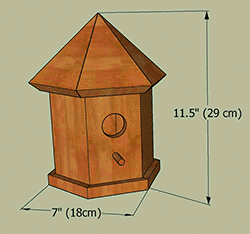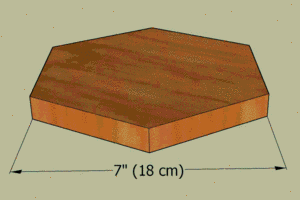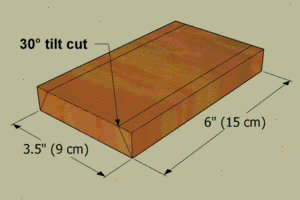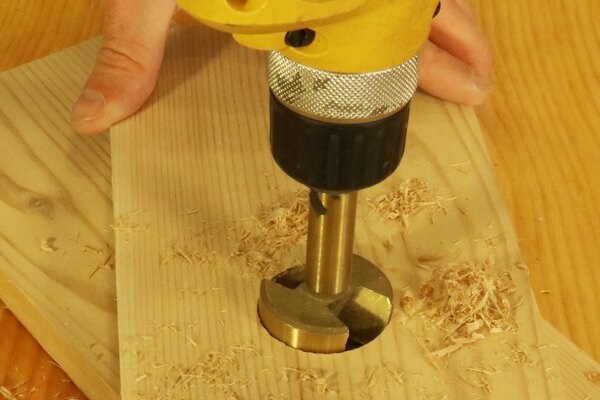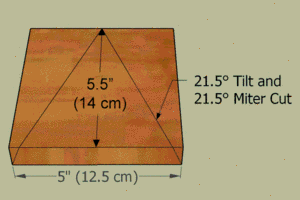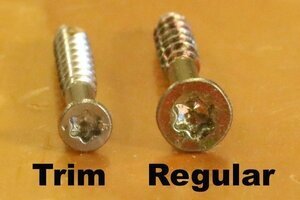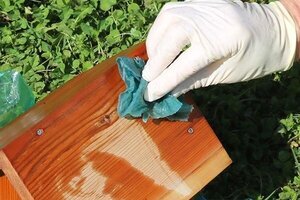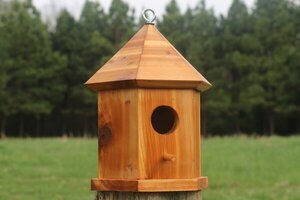Bird House Plans – Gazebo Nesting Box for Bluebirds & Wrens
Free DIY bird house plans to make a gazebo (6-sided) hexagon nesting box. This birdhouse can be used to attract bluebirds, swallows, chickadees, nuthatches, warblers, woodpeckers, wrens, and other birds to your backyard or garden. Find more free bird houses plans or discover more nesting boxes and bird feeders.
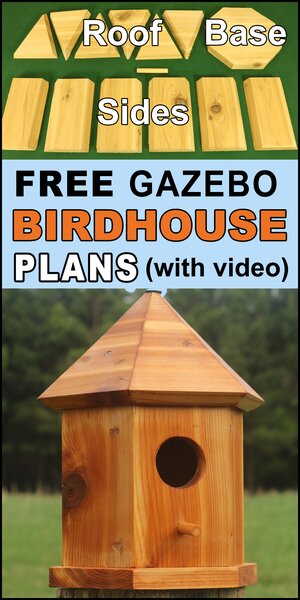
Materials and Equipment Needed to Build this Birdhouse:
- Wood (cedar, redwood, cypress, and pine would make good choices).
- Screws: Approximately 1.5″ (4cm) long.
- Power drill.
- Saw (table saw or miter saw).
- Drill bit to match appropriate entrance hole size.
Step 1. Prepare the base or the bottom of the bird house.
Cut a 6-sided (hexagon) using a miter saw, table saw, band saw, or other saw. The distance from one side to the other side should be 7″ (18 cm). Drill several 1/4″ (0.5 cm) holes in the floor for drainage. Note, two smaller pieces of wood can also be used for the bottom. If so, when assembling leave a small gab between the two pieces for drainage.
Step 2. Create the sides of the gazebo bird house.
Cut six pieces for the sides on a table saw or miter saw with the blade set at a 30 degree tilt. Each piece should be 6″ x 3.5″ (15cm x 9cm).
Step 3. Drill the entrance hole for the birdhouse.
Drill a hole for the entrance using either a spade bit or forsnter drill bit. A 1.5″ (4 cm) entrance hole is the optimum diameter for bluebirds and tree swallows. However, chickadees, nuthatches, warblers, woodpeckers, and wrens will also gladly make this their home. See Bird House Hole Size if you want to attract a specific bird.
Step 4. Cut the roof of the bird house.
Cut six pieces for the roof with a 21.5 degree tilt and a 21.5 degree miter cut. When finished each piece should be approximately 5.5″ x 5″ (14cm x 12.5cm).
When assembled, the roof will be at a 43 degree angle. If you wish your roof to be at a different angle see segmented wood turning. Here you will find the required miter and tilt cuts necessary for other angles.
Step 5. Assemble the bird house.
Altogether, you should now have six roof sections (labeled “A” on the image below), the base or the floor (labeled “B”), and six sides (labeled “C”). Now, use a combination of glue and screws to attach the sides, base (floor), and the roof of the birdhouse together. A waterproof wood glue is recommended to help extend the life of the birdhouse. Drill pilot holes to help prevent the wood from splitting. Ideally the pilot holes should be at least as large as the screw’s minor diameter. Personally, I recommend using stainless steel trim screws as shown below. The smaller screw head is less obvious and helps prevent the wood from splitting. If you pre-drill the holes, these screws will countersink themselves nicely because the head is not much larger than the pilot hole.
Attach the roof to the birdhouse using only screws. This way, it can later be opened for cleaning. Find other ways to add a clean out door to this birdhouse.
Step 6. Optionally paint or finish your birdhouse.
In our case, we applied a linseed-oil. This finish helps accentuate the grain and helps make the wood more resistant to damage.
Step 7. Hang or mount your birdhouse.
Mount your birdhouse and see which bird will call your habitat home. See How to Hang a Birdhouse for the recommended mounting height for various birds. Your new birdhouse should provide you excitement for many seasons to come.
Building a birdhouse can be fun family project. Furthermore, a birdhouse will help encourage neighborhood birds to move in and raise families in your backyard. Hence providing you and your garden natural pest control.
Related Articles on Bird Houses, Bird Feeders & More
Use these free DIY bird house plans and bird feeder plans to attract bluebirds, chickadees, flickers, finches, house sparrows, hummingbirds, kestrel, nuthatches, owls, purple martins, swallows, thrushes, warblers, woodpeckers, wrens, and other birds to your garden.
